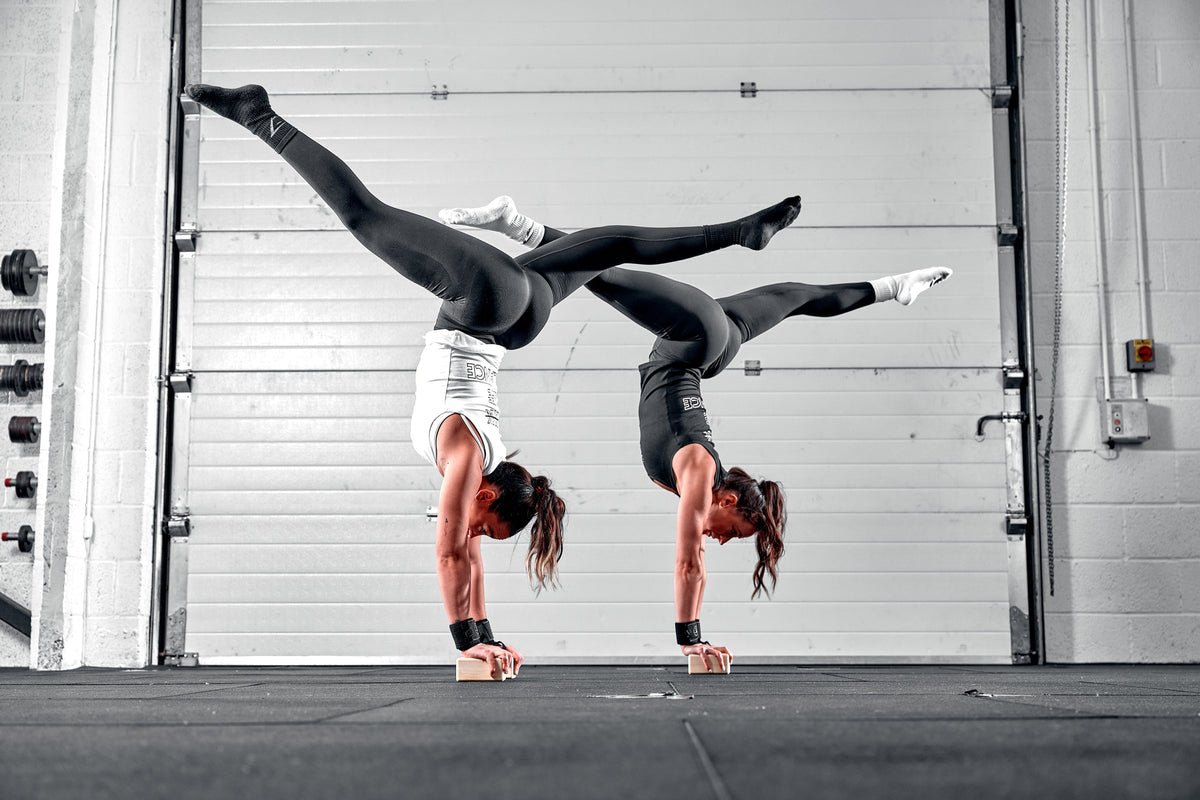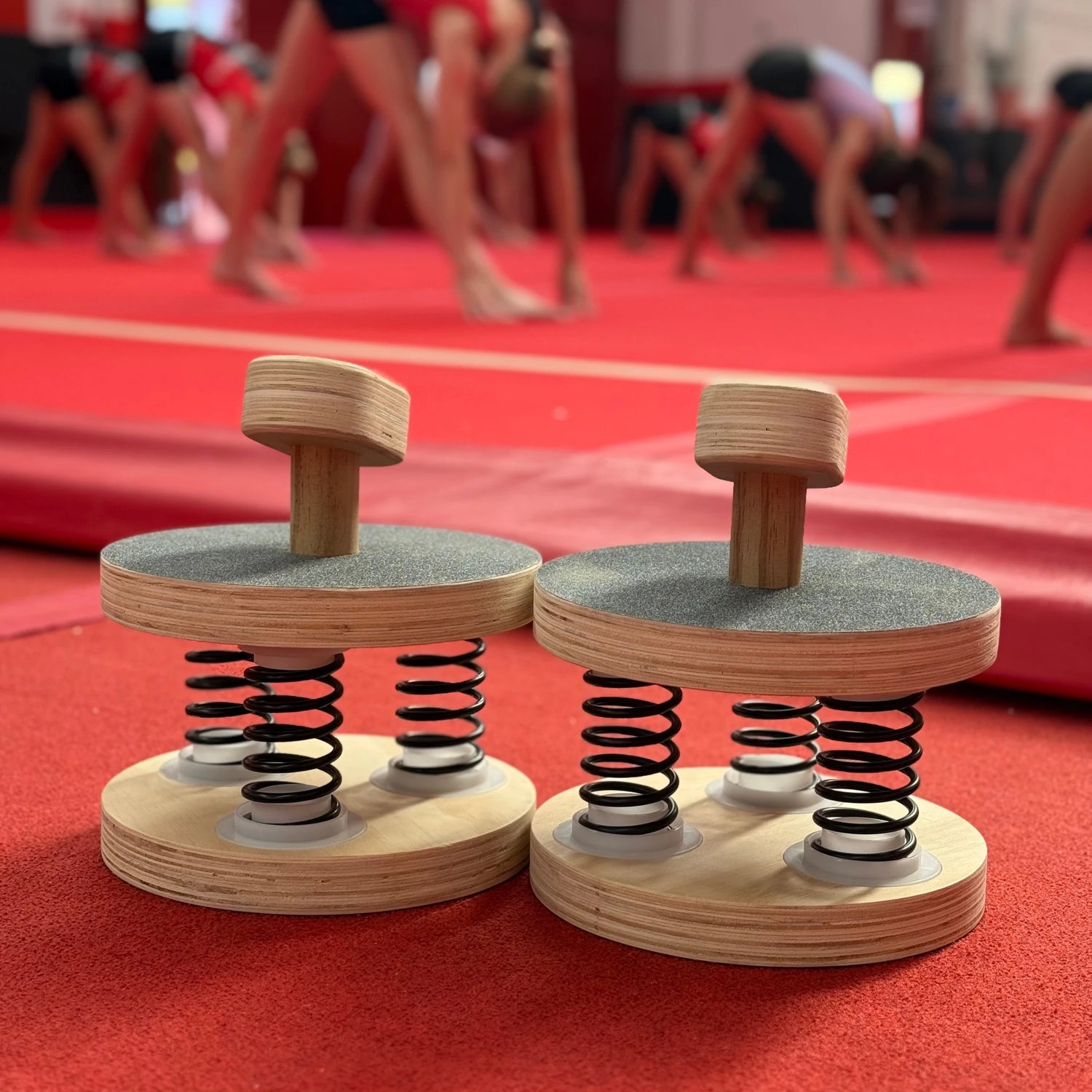
15 Perfect Gymnastics Exercises For A Home Workout
|
|
Time to read 6 min

Check out our exciting new balance product launches. Developed and tested by...
|
|
Time to read 6 min
Gymnastics is a sport that demands exceptional strength, flexibility, and coordination. Whether you're a beginner gymnast looking to improve your skills or an experienced athlete aiming to maintain your form, incorporating effective gymnastics exercises into your home workout routine can offer significant benefits.
This guide explores 15 perfect gymnastics exercises that you can perform at home, focusing on essential skills, conditioning, and injury prevention.
A handstand hold is an excellent exercise to build upper body strength and improve balance. Start in a standing position, then kick up into a handstand against a wall for support. Keep your body in a straight line, engage your core, and hold the position for 20-30 seconds.
These gymnastics exercises enhance shoulder strength, upper back stability, and overall gymnastic skills.
Tips: Ensure your head remains neutral and your legs are straight for proper alignment.
Push-ups are a great way to strengthen your upper body, particularly the chest, shoulders, and triceps. Begin in a plank position with your hands slightly wider than shoulder-width apart.
For these gymnastics exercises, lower your body until your chest nearly touches the floor, then push back up. For a gymnastic twist, you can add a shoulder tap or perform them with your feet elevated to increase difficulty.
Tips: Maintain good form by keeping your body in a straight line and avoiding sagging at the hips.
Leg lifts target the lower abdominal muscles and hip flexors, which are crucial for various gymnastics exercise movements. Lie on your back with your hands under your hips for support.
Lift your legs towards the ceiling while keeping them straight, then lower them back down without touching the ground. Perform 15-20 repetitions for a solid core workout.
Tips: Focus on engaging your core and keeping your lower back pressed into the floor to avoid strain.
Forward rolls are fundamental gymnastics drills that improve body control and rolling technique. Start in a standing position, tuck your chin to your chest, and roll forward, keeping your body in a tight ball.
Practice landing on your feet or in a squat position to enhance your landing mechanics.
Tips: Ensure a smooth roll by using your shoulders and back muscles to guide the movement.
Similar to forward rolls, back rolls help with body awareness and coordination. Start lying on your back, tuck your knees to your chest, and roll backward over your shoulders.
Finish the roll by coming back to a standing or sitting position. This exercise is particularly useful for practicing backward rotation.
Tips: Keep your head neutral and focus on rolling smoothly over your shoulders to avoid strain on your neck.
The plank hold are powerful gymnastics exercises that strengthens the core, upper body, and lower back. Start in a push-up position and hold your body in a straight line from head to heels. Engage your core and hold the position for 30-60 seconds.
This exercise is fundamental for building a strong foundation for more advanced gymnastics skills.
Tips: Keep your hips level and avoid letting them sag or rise during the hold.
The front scale is a balance exercise that enhances core strength and flexibility. Start in a standing position and extend one leg straight out in front of you while reaching your arms forward.
Hold these gymnastics exercises for a few seconds before returning to the starting position. Make sure to repeat on the other leg.
Tips: Focus on maintaining a straight line from your head to your toes and engaging your core to stabilize the position.
The back scale is similar to the front scale but requires extending one leg behind you.
Begin in a standing position, extend one leg straight behind you, and lean forward while reaching your arms forward. Hold the position for a few seconds before switching legs.
Tips: Keep your hips level and your back straight to avoid straining your lower back.
Straight leg kicks improve hamstring flexibility and core strength. Stand on one leg and kick the other leg straight out in front of you, keeping it as straight as possible.
Alternate legs and perform 10-15 kicks on each side.
Tips: Keep your core engaged and your body upright to maximize the effectiveness of the exercise.
Back handspring drills are crucial for mastering this advanced gymnastics skill. Start these gymnastics exercises in a standing position, jump backward, and kick your legs over while pushing off with your arms.
Use a soft surface, such as a panel mat or a thick carpet, to practice safely. These drills build the strength and technique needed for a clean back handspring.
Tips: Focus on keeping your arms straight and your body in a tight, controlled position throughout the movement.
Front splits are essential for developing flexibility in the hamstrings and hip flexors.
Start in a standing position, step one leg forward, and lower your hips towards the ground, keeping both legs straight. Hold the stretch for 30 seconds and then switch legs.
Tips: Warm up properly before attempting splits to prevent injury and use a yoga mat or towel for added comfort.
The back scale with leg lift combines balance and strength training. Perform the back scale exercise, but add a small lift of the extended leg while holding the balance. This variation enhances core stability and improves the overall difficulty of the exercise.
Tips: Engage your core and maintain good form to prevent strain on your lower back and hips.
Tricep dips target the upper arm muscles, which are crucial for various gymnastics skills. Use a sturdy chair or bench for support.
Place your hands behind you on the chair, extend your legs forward, and lower your body until your elbows are at a 90-degree angle. Push back up to the starting position.
Tips: Keep your elbows close to your body and avoid letting your shoulders hunch during the exercise.
A hip flexor stretch is one of the essential gymnastics exercises for improving flexibility and reducing the risk of injury. Kneel on one knee with the other foot in front, forming a 90-degree angle with both legs.
Push your hips forward gently to stretch the hip flexor of the kneeling leg. Hold the stretch for 30 seconds and switch legs.
Tips: Ensure you keep your back straight and engage your core to avoid excessive strain on the lower back.
Bodyweight squats are fundamental for developing lower body strength, particularly in the gluteal muscles and quadriceps.
Stand with your feet shoulder-width apart and lower your body into a squat position, keeping your back straight and your knees behind your toes. Rise back to the starting position and repeat.
Tips: Focus on maintaining proper form and control throughout the movement to maximize muscle engagement and reduce the risk of injury.
1. Creating a Balanced Routine:
To achieve the best results, incorporate a mix of these exercises into your workout plan. Aim for a combination of strength training, flexibility exercises, and gymnastic drills.
2. Conditioning Workout Plan:
Use these exercises as part of a broader conditioning workout plan. Include exercises that target different muscle groups and focus on building core strength, upper body power, and lower body flexibility.
3. Safety and Injury Prevention:
Always warm up before starting your workout to prepare your muscles and reduce the risk of injury. Pay attention to proper form and technique to prevent strain and ensure effective training.
4. Progression and Skill Development:
As you advance in your training, challenge yourself with more complex movements and variations. Gradually increase the difficulty of your exercises to progress to the next level of gymnastics skills.
5. Using Home Gymnastics Equipment:
If available, incorporate home gymnastics equipment such as a pull-up bar or resistance bands to enhance your workout. These tools can add variety and increase the intensity of your exercises.
"The only way to achieve your dreams is through hard work and dedication."
Incorporating gymnastics exercises into your home workout routine offers a great opportunity to develop strength, flexibility, and skill.
From basic drills like forward rolls and leg lifts to more advanced movements such as back handsprings and front splits, these exercises cater to gymnasts of all levels.
By focusing on good form, injury prevention, and consistent training, you can achieve significant improvements in your gymnastics skills and overall fitness. So, roll out your mat, use your bodyweight effectively, and get started on your path to enhanced performance and fitness. Good luck with your gymnastics exercises!





